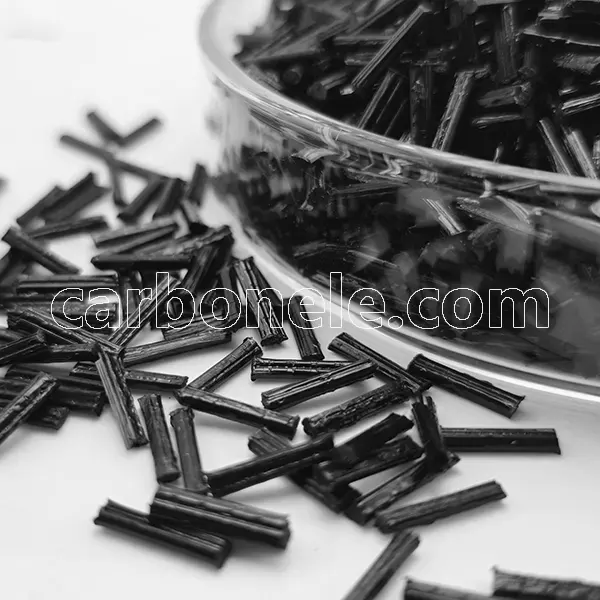Surface Modification Method Of Carbon Fiber In Nylon Composites - Carbon Fiber Compounds Manufacturer | Supplier
Modern industry makes extensive use of nylon composites because of its great mechanical qualities and low weight. Particularly in the domains of aircraft, cars, sports equipment, etc., this kind of material performs really remarkably. Still, surface modification of carbon fiber has become a major focus of study if it is to raise performance even further. Direct influence of the bonding quality of carbon fiber and nylon matrix on the whole performance of composite materials. Therefore, enhancing the performance of nylon composite materials depends much on researching the surface modification technique of carbon fiber.

Nylon carbon fiber composite material
Need of carbon fiber surface modification
Many high-end applications have completely confirmed the great performance of carbon fiber; yet, its interfacial bonding with the nylon matrix remains a major problem. The mechanical qualities and service lifetime of the material are affected by the weak connection between carbon fiber and the nylon matrix resulting from their smooth surface and lack of chemical reactivity. Surface modification of carbon fiber has become a useful approach to overcome this issue in order to raise the interfacial bonding strength.
The particular application environment and performance criteria of carbon fiber demand that the choice and application technique be changed. By means of modification, more active groups may be included on the surface of carbon fiber, which can react chemically with the nylon matrix, thus enhancing the interfacial bonding performance. Moreover, alteration may increase the wettability of carbon fiber thereby enhancing its dispersion and bonding in the nylon matrix. In addition to strengthening and toughening the composite material, this increases its dependability and longevity.
System of chemical modification
Common technique in carbon fiber surface modification is chemical modification method, which mostly inserts functional groups on the surface of carbon fiber via chemical reaction. These groups may chemically interact with the nylon matrix to improve the two’s bonding. Among common techniques of chemical modification are oxidation, fluorination, amination, etc.
Most often used is oxidation modification. Oxidation treatment allows the introduction on the surface of carbon fiber polar functional groups like carboxyl and alcohol groups. Strong chemical interactions formed by these functional groups reacting chemically with amino or carboxyl groups in the nylon matrix help to improve the interface bonding performance. Furthermore enhancing the corrosion resistance and chemical stability of carbon fiber is fluorination modification. Amino groups introduced via amination modification not only react with the nylon matrix but also increase the wettability of carbon fiber.
Physical modification techniques
Physical modification techniques alter the surface characteristics of the carbon fiber by physical means to enhance its bonding capacity with the nylon matrix. Common techniques of physical alteration include spraying technology, laser therapy, and plasma treatment.
By use of high-energy plasma, plasma treatment is a technique producing active groups on the surface of carbon fiber. On the surface of carbon fiber, plasma treatment may provide a great variety of functional groups that enhance bonding strength with the nylon matrix. By means of laser beams, laser treatment etches minute textures on the surface of carbon fiber, thereby improving the interfacial bonding performance and surface area. To increase the bonding capacity of carbon fiber with the nylon matrix, sprays of chemically reactive coating are applied on its surface.
application of composite modification techniques
Better modification effects are sometimes obtained in practical applications by use of composite modification techniques. On the surface of carbon fiber, combining chemical and physical modification allows many purposes. Apart from enhancing the interfacial bonding performance of carbon fiber, this approach may also raise its mechanical strength and durability.
For instance, combining amino modification with plasma treatment may provide additional functional groups on the surface of carbon fiber, thereby improving interfacial bonding by raising surface roughness. Furthermore, composite modification may maximize the modification impact by changing the modification parameters to satisfy the requirements of many application domains. This approach is extensively used in the manufacturing of nylon composites because its adaptability and efficiency.
Difficulties and possibilities of changing strategies
The surface modification technique of carbon fiber still presents numerous difficulties even if considerable development has been achieved here. For instance, the strength and elastic modulus of carbon fiber may change with the modification process; so, the circumstances must be closely under control throughout the modification process. Important considerations also include the economic and environmental effect of the change strategy.
With the advancement of technology, the surface modification technique of carbon fiber is projected to be much more perfected. The development of new modification technologies could alleviate certain issues with the current techniques and enhance the modification impact. Simultaneously, the creativity of modification techniques will enable the realization of nylon composites’ wider application potential and aid to promote their use in additional spheres. By means of ongoing research and development, surface modification technology of carbon fiber will provide robust support for the performance enhancement and application extension of nylon composites.

PA6 LCF50 50% Carbon Fiber NYLON 6 Composites
summary
Improving the performance of nylon composites depends on carbon fiber being surface modified. The bonding force between carbon fiber and nylon matrix may be much enhanced by means of chemical modification, physical modification, and composite modification techniques, therefore enhancing the mechanical qualities and durability of composite materials. Although there are still some difficulties, with the advancement of technology, carbon fiber surface modification technology will become more and more significant in the use of nylon composite materials, so providing more prospects and development space for associated sectors.
Previous News
Comparison of the properties of PA6 CF thermopl...Next News
Introduction to the molding process and applica...
Feature Product
-
PA12 LCF30 for Drone Fuselages & Wings
What do you know about PA12 LCF30? PA12 ...
-
Competitive Price PA6 LCF30 Composites
What’s it? PA6 LCF30, which stands...
-
ABS CF10 Compound ABS 10%CF Thermoplastic Compo...
What’s ABS CF10? ABS CF10 refers t...








